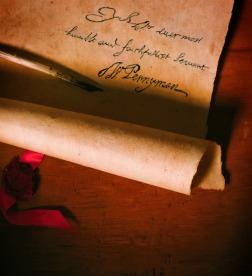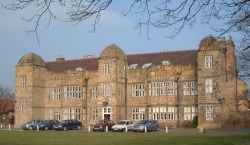The history of the original regiment

The C17th regiment was the oldest regiment in the Royalist Army, originally raised in the war with the Scots 1638-9 when Sir William Pennyman, a wealthy landowner, raised a Regiment of Foote from the
Yorkshire Trained Bands.
Born in 1607, Sir William matriculated from Christ Church, Oxford, in 1623 aged sixteen, and was admitted a student of the Inner Temple later in the same year. Recommended by Thomas Wentworth, Earl of Strafford, he became a distinguished JP, Deputy Lord Lieutenant of Yorkshire and a member of the Council of the North. Sir William held rights on alum mining (alum being a double sulphate of aluminium and potassium) a mineral compound vital to many chemical processes including paper making. Consequently he was a very wealthy and influential young man.
More significantly, in the context of the gathering storm, Pennyman was also a lawyer prior to the First Civil War, holding an office in the arbitrary court of Star Chamber which was worth a full £2000 p.a. When writing of her late husband in her "Memoirs of Colonel Hutchinson", Lucy Hutchinson refers to Sir William thus:
"Sir William Pennyman, who had married his cousin-german, a very worthy gentleman, who had great respect for and from his father, had purchased the chief office in the Star-Chamber; the gentleman who held the next to him was careless and debauched and thereby a great hindrance of Sir William's profits, who apprehended that if he could get an honest man into that place, they might mutually advantage each other; whereupon he persuaded Mr. Hutchinson to buy the place, and offered him any terms, to go any share with him, or any way he could desire."
Sir William thought that he had persuaded Hutchinson to buy out his partner, but negotiations with the third party failed and the would-be partners became, at the outbreak of the War, adversaries.
Marske Hall - the birthplace of our Regiment

Pennyman represented Richmond , Yorkshire, for the two Parliaments called in 1640. Acting as a witness to Strafford's character at his trial concerning the Yorkshire Petition (i.e. the illegal levy of money to support the Yorkshire trained Bands) and to Strafford's boast that he would "make the little finger of the King heavier than the loins of the law", he went on to vote against the Bill of Attainder that led to the Earl's execution in 1641.
When war seemed imminent between King Charles I and Parliament, Sir William and his cousin James Pennyman, who raised a troop of horse to serve with Prince Rupert of the Rhine, took the Regiment to the King's Standard at Nottingham 1642.
Pennyman's Regiment served with distinction throughout the war. The Regiment fought at the Battle of Edgehill (1642) where Sir William was both present and in command of a Troop of cavalry in Prince Rupert's Regiment and also at the capture of Marlborough (1642). Sir William died of the plague in Oxford, whilst Governor (1643) "to the great sadness of all men". His wife, Anne, followed him to the grave within a year and lies buried with him.
Sir James took over as Colonel of Sir William Pennyman's Regiment. Under his leadership the Regiment fought at Newbury (1643) and Copredy Bridge (1644). Progressing into Cornwall, Pennyman's fought in the Lostwithiel campaign (1644). Sir James retired and the Regiment was commanded by Sir Richard Page at the storming of Leicester (1645) and at Naseby (1645) when the Colonel was captured and the regiment destroyed.
Sadly, we have no extant likeness of Sir William Pennyman, but the image at the top of this page shows an example of his hand on a letter written at Marske Hall in 1637, prior to the raising of his Regiment.
Return to top.
